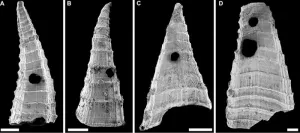(Press-News.org) University of Arizona researchers have revealed new insights into one of the most common complications faced by Parkinson's disease patients: uncontrollable movements that develop after years of treatment.
Parkinson's disease – a neurological disorder of the brain that affects a person's movement – develops when the level of dopamine, a chemical in the brain that's responsible for bodily movements, begins to dwindle. To counter the loss of dopamine, a drug called levodopa is administered and later gets converted into dopamine in the brain. However, long-term treatment with levodopa induces involuntary and uncontrollable movements known as levodopa-induced dyskinesia.
A study published in the journal Brain has uncovered new findings about the nature of levodopa-induced dyskinesia and how ketamine, an anesthetic, can help address the challenging condition.
Over the years, the brain of a Parkinson's patient adapts to the levodopa treatment, which is why levodopa causes dyskinesia in the long term, said Abhilasha Vishwanath, the study's lead author and a postdoctoral research associate in the U of A Department of Psychology.
In the new study, the research team found that the motor cortex – the brain region responsible for controlling movement – becomes essentially "disconnected" during dyskinetic episodes. This finding challenges the prevailing view that the motor cortex actively generates these uncontrollable movements.
Because of the disconnect between motor cortical activity and these uncontrollable movements, there's probably not a direct link, but rather an indirect way in which these movements are being generated, Vishwanath said.
The researchers recorded activity from thousands of neurons in the motor cortex.
"There are about 80 billion neurons in the brain, and they hardly shut up at any point. So, there are a lot of interactions between these cells that are ongoing all the time," Vishwanath said.
The research group found that these neurons' firing patterns showed little correlation with the dyskinetic movements, suggesting a fundamental disconnection rather than direct causation.
"It's like an orchestra where the conductor goes on vacation," said Stephen Cowen, senior author of the study and an associate professor in the Department of Psychology. "Without the motor cortex properly coordinating movement, downstream neural circuits are left to spontaneously generate these problematic movements on their own."
This new understanding of dyskinesia's underlying mechanism is complemented by the team's findings regarding the therapeutic potential of ketamine, a common anesthetic. The research demonstrated that ketamine could help disrupt abnormal repetitive electrical patterns in the brain that occur during dyskinesia. This could potentially help the motor cortex to regain some control over movement.
Ketamine works like a one-two punch, Cowen said. It initially disrupts these abnormal electrical patterns occurring during dyskinesia. Then, hours or days later, ketamine triggers much slower processes that allow for changes in the connectivity and activity of brain cells over time, known as neuroplasticity, that last much longer than ketamine's immediate effects. Neuroplasticity is what that enables neurons to form new connections and strengthen existing ones.
With one dose of ketamine, beneficial effects can be seen even after a few months, Vishwanath said.
These findings gain additional significance in light of an ongoing Phase 2 clinical trial at the U of A, where a group of researchers from the Department of Neurology are testing low doses of ketamine infusions as a treatment for dyskinesia in Parkinson's patients. Early results from this trial appear promising, Vishwanath said, with some patients experiencing benefits that last for weeks after a single course of treatment.
Ketamine doses could be tweaked in a way such that the therapeutic benefits are maintained with minimized side effects, Cowen said. Entirely new therapeutic approaches may also be developed based on the study's findings about motor cortex involvement in dyskinesia.
"By understanding the basic neurobiology underlying how ketamine helps these dyskinetic individuals, we might be able to better treat levodopa-induced dyskinesia in the future," Cowen said.
The study received funding from National Institute of Neurological Disorders and Stroke (grants R56 NS109608 and R01 NS122805) and Arizona Biomedical Research Commission (grant ADHS18-198846).
END
Brain study challenges long-held views about Parkinson's movement disorders
2025-01-03
ELSE PRESS RELEASES FROM THIS DATE:
Mental disorders among offspring prenatally exposed to systemic glucocorticoids
2025-01-03
About The Study: In this cohort study, prenatal exposure to glucocorticoids was associated with higher risk of some mental disorders. These data support continued caution in the use of glucocorticoids in pregnant people.
Corresponding Author: To contact the corresponding author, Kristina Laugesen, PhD, email kristina.laugesen@clin.au.dk.
To access the embargoed study: Visit our For The Media website at this link https://media.jamanetwork.com/
(doi:10.1001/jamanetworkopen.2024.53245)
Editor’s Note: Please see the article for additional information, including other authors, author contributions ...
Trends in screening for social risk in physician practices
2025-01-03
About The Study: In this survey-based cross-sectional study of U.S. physician practices, social risk screening increased substantially from 2017 to 2022, although still less than one-third of practices systematically screened for a set of 5 common social risks (food, housing, utilities, interpersonal violence, and transportation). What remains to be seen is whether practices use these data to help improve patient health by adjusting health care or referring patients for assistance with social needs. As policies and incentives increasingly emphasize social risk screening, it will be important to assess the association of screening and referrals with patient ...
Exposure to school racial segregation and late-life cognitive outcomes
2025-01-03
About The Study: This cross-sectional study of Black and white older individuals found that childhood exposure to school segregation was associated with late-life cognition among the Black population. Given the increasing amount of school segregation in the U.S., educational policies aimed at reducing segregation are needed to address health inequities. Clinicians may leverage patients’ early-life educational circumstances to promote screening, prevention, and management of cognitive disorders.
Corresponding Author: To contact the corresponding author, Xi Chen, PhD, email xi.chen@yale.edu.
To ...
AI system helps doctors identify patients at risk for suicide
2025-01-03
A new study from Vanderbilt University Medical Center shows that clinical alerts driven by artificial intelligence (AI) can help doctors identify patients at risk for suicide, potentially improving prevention efforts in routine medical settings.
A team led by Colin Walsh, MD, MA, associate professor of Biomedical Informatics, Medicine and Psychiatry, tested whether their AI system, called the Vanderbilt Suicide Attempt and Ideation Likelihood model (VSAIL), could effectively prompt doctors in three neurology clinics at VUMC to screen patients for suicide risk during regular clinic visits.
The study, reported in JAMA Network Open, compared two approaches — automatic ...
Advanced imaging uncovers hidden metastases in high-risk prostate cancer cases
2025-01-03
A new study led by researchers at the UCLA Health Jonsson Comprehensive Cancer Center has found that many cases of high-risk nonmetastatic hormone-sensitive prostate cancer may be more advanced than previously thought.
The study, published in JAMA Network Open, found that nearly half of high-risk prostate cancer patients previously classified as nonmetastatic by conventional imaging actually have metastatic disease when evaluated with advanced prostate-specific membrane antigen–positron emission tomography (PSMA-PET) ...
Study reveals oldest-known evolutionary “arms race”
2025-01-03
A new study led by researchers at the American Museum of Natural History presents the oldest known example in the fossil record of an evolutionary arms race. These 517-million-year-old predator-prey interactions occurred in the ocean covering what is now South Australia between a small, shelled animal distantly related to brachiopods and an unknown marine animal capable of piercing its shell. Described today in the journal Current Biology, the study provides the first demonstrable record of an evolutionary arms race in the Cambrian.
“Predator-prey interactions are often touted as a major driver of the Cambrian explosion, ...
People find medical test results hard to understand, increasing overall worry
2025-01-03
In April 2021, a provision in the 21st Century Cures act took effect which required that all medical test results be released to a patient’s electronic medical record as soon as they become available.
As a result of this newer law, many patients are seeing and reading their test results even before their doctor has.
The problem is that many medical reports aren’t written with patients in mind.
For example, “a standard pathology report is written by a pathologist for a clinical specialist like a surgeon or ...
Mizzou researchers aim to reduce avoidable hospitalizations for nursing home residents with dementia
2025-01-03
COLUMBIA, Mo. -- For many nursing home residents, a trip to the hospital can be a jarring experience — one that leaves them confused and stressed. Yet avoidable transfers happen far too often, not only disrupting a resident’s routine but also costing the U.S. healthcare system $2.6 billion annually.
When researchers at the University of Missouri recently looked at the decision-making process for whether or not to transfer nursing home residents to the hospital, they quickly discovered that it’s complicated — particularly for residents with cognitive impairment who may not ...
National Diabetes Prevention Program saves costs for enrollees
2025-01-03
About 1 in 3 adults in the United States have prediabetes, a condition where blood glucose levels are higher than normal, but not high enough to be diagnosed as diabetes.
Affecting 98 million adults, prediabetes can increase the risk of heart disease, stroke and type 2 diabetes.
While it can be reversed, 8 in 10 adults are unaware that they even have prediabetes.
To counter this growing problem, the National Diabetes Prevention Program was created by the Centers for Disease Control and ...
Research team to study critical aspects of Alzheimer’s and dementia healthcare delivery
2025-01-03
Kosali Simon, PhD, M.A., a professor with the Paul H. O’Neill School of Public and Environmental Affairs and a Regenstrief Institute research scientist; and Katherine Baicker, PhD, University of Chicago provost, will co-lead an expected nearly $16 million National Institutes of Health’s (NIH) National Institute on Aging (NIA) program to explore critical aspects of healthcare delivery for individuals living with Alzheimer’s disease and related dementias (ADRD).
This five-year research initiative aims to identify and address barriers to equitable and effective healthcare for this growing patient population. The ...


